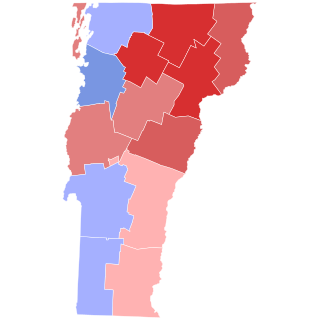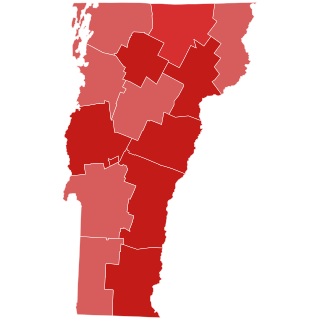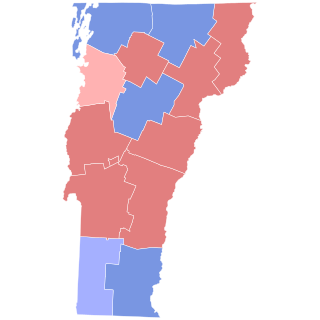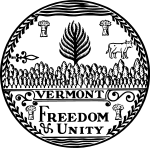
The 2002 Vermont gubernatorial election took place on November 5, 2002. Incumbent Democratic Governor Howard Dean did not run for re-election to a sixth full term as Governor of Vermont. Republican Jim Douglas defeated Democratic candidate Doug Racine and independent candidate Cornelius Hogan, among others, to succeed him. Since no candidate received a majority in the popular vote, Douglas was elected by the Vermont General Assembly per the state constitution.

The 1988 Vermont gubernatorial election took place on November 8, 1988. Incumbent Democrat Madeleine Kunin ran successfully for re-election to a third term as Governor of Vermont, defeating Republican candidate Michael Bernhardt.

The 1980 Vermont gubernatorial election took place on November 4, 1980. Incumbent Republican Richard A. Snelling ran successfully for a third term as Governor of Vermont, defeating Democratic candidate M. Jerome Diamond.

The 1978 Vermont gubernatorial election took place on November 7, 1978. Incumbent Republican Richard Snelling ran successfully for a second term as Governor of Vermont, defeating Democratic candidate Edwin Granai. As of 2014, this was the most recent Vermont gubernatorial election in which both major party candidates are now deceased.

The 1976 Vermont gubernatorial election took place on November 2, 1976. Incumbent Democrat Thomas P. Salmon did not seek another term as Governor of Vermont, instead running for United States Senate. Republican candidate Richard A. Snelling won the election, defeating Democratic candidate Stella B. Hackel and Liberty Union candidate Bernie Sanders.

The 1974 Vermont gubernatorial election took place on November 5, 1974. Incumbent Democrat Thomas P. Salmon ran successfully for a second term as Governor of Vermont, defeating Republican candidate Walter L. Kennedy and Liberty Union candidate Martha Abbott.

The 1972 Vermont gubernatorial election took place on November 7, 1972. The incumbent Republican Gov. Deane C. Davis was not a candidate for re-election to another term as Governor of Vermont. The Democratic nominee, Thomas P. Salmon, defeated the Republican nominee, Luther F. Hackett, to become his successor. Future U.S. senator and presidential candidate Bernie Sanders ran as a member of the Liberty Union Party.

The 1970 Vermont gubernatorial election took place on November 3, 1970. Incumbent Republican Deane C. Davis ran successfully for re-election to a second term as Governor of Vermont, defeating Democratic candidate Leo O'Brien Jr.

The 1968 Vermont gubernatorial election took place on November 5, 1968. Incumbent Democrat Philip H. Hoff did not run for re-election to another term as Governor of Vermont. Republican candidate Deane C. Davis defeated Democratic candidate John J. Daley to succeed him.

The 1966 Vermont gubernatorial election took place on November 8, 1966. Incumbent Democrat Philip H. Hoff ran successfully for re-election to a third term as Governor of Vermont, defeating Republican candidate Richard A. Snelling.

The 1964 Vermont gubernatorial election took place on November 3, 1964. Incumbent Democrat Philip H. Hoff ran successfully for re-election to a second term as Governor of Vermont, defeating Republican candidate Ralph A. Foote.

The 1962 Vermont gubernatorial election took place on November 6, 1962. Incumbent Republican F. Ray Keyser Jr. ran unsuccessfully for re-election to a second term as Governor of Vermont, losing to Democratic candidate Philip H. Hoff. Hoff was the first Democrat elected Governor of Vermont since 1853. This was also the last time an incumbent governor of Vermont was defeated for re-election.

The 1960 Vermont gubernatorial election took place on November 8, 1960. Incumbent Republican Robert Stafford did not run for re-election to a second term as Governor of Vermont. Republican candidate F. Ray Keyser Jr. defeated Democratic candidate Russell F. Niquette to succeed him.

The 1958 Vermont gubernatorial election took place on November 4, 1958. Incumbent Republican Joseph B. Johnson did not run for re-election to a third term as Governor of Vermont. Republican candidate Robert Stafford defeated Democratic candidate Bernard J. Leddy to succeed him.

The 1956 Vermont gubernatorial election took place on November 6, 1956. Incumbent Republican Joseph B. Johnson ran successfully for re-election to a second term as Governor of Vermont, defeating Democratic candidate E. Frank Branon.

The 1954 Vermont gubernatorial election took place on November 2, 1954. Incumbent Republican Lee E. Emerson did not run for re-election to a third term as Governor of Vermont. Republican candidate Joseph B. Johnson defeated Democratic candidate E. Frank Branon to succeed him.

The 1952 Vermont gubernatorial election took place on November 4, 1952. Incumbent Republican Lee E. Emerson ran successfully for re-election to a second term as Governor of Vermont, defeating Democratic candidate Robert W. Larrow and write-in candidate Henry D. Vail.

The 1950 Vermont gubernatorial election took place on November 7, 1950. Incumbent Republican Harold J. Arthur, who had become governor following the resignation of Ernest W. Gibson Jr., did not run for a full term as Governor of Vermont. Republican candidate Lee E. Emerson defeated Democratic candidate J. Edward Moran and succeeded Arthur.

The 1948 Vermont gubernatorial election took place on November 2, 1948. Incumbent Republican Ernest W. Gibson Jr. ran successfully for re-election to a second term as Governor of Vermont, defeating Democratic candidate Charles F. Ryan, a Vermont Army National Guard officer and former assistant U.S. Attorney for Vermont.

The 1982 United States Senate election in Vermont took place on November 2, 1982. Incumbent Republican Robert Stafford successfully ran for re-election to another term in the United States Senate, defeating Democratic candidate James A. Guest. This election marks the last time a Democrat won any counties in a race for Vermont's Class 1 US Senate seat, as well as the last time the winner of the seat did not win every county in the state.
























